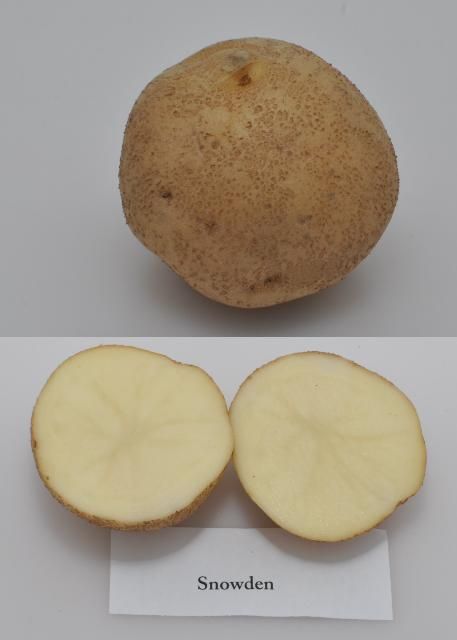There are several potato varieties available in the market today. Most of them have been bred or developed in production regions other than Florida. The University of Florida Potato Variety Evaluation Program screens new germplasm from public and private breeding programs and identifies the most promising cultivars for commercial potential considering broad adaptability to Florida climate and conditions and market purpose: processing, fresh-market and specialty-type varieties. Over the years, the UF/IFAS Potato Variety Program has become an important reference to vegetable growers, seed producers, processors, crop insurance agencies, and brokers looking for alternative potato varieties to explore different markets, improved characteristics, and yield. This UF/Potato Variety Trials Spotlight presents a summary of the field evaluation of tuber yield and quality performance of the potato variety 'Snowden' cultivated in Florida.
General Comments
'Snowden' is a potato variety that is commonly grown for the potato chip market. It was selected from a cross of 'Le-nape' and 'Wischip' by Dr. Stan Peloquin and Mr. Donald Kichefski at the University of Wisconsin. It was named and released in 1990 from the University of Wisconsin's Lelah Starks Potato Breeding Farm in Rhinelander, WI. Tuber production and quality results provided in this spotlight are summarized from various variety trials conducted by the UF/IFAS Hastings Agricultural Extension Center from 1998 to 2019.
General Characteristics
'Snowden' stems have an upright growth habit that gives this variety a competitive advantage over many weed species. Both stems and leaves have a slight pubescence. Tubers have light-tan and slightly netted skin with a white flesh (Figure 1) according to Florida's rating codes for potato tuber characteristics (Table 1). The tubers are uniform with a round to slightly flat shape. The eyes are of medium size and are uniformly distributed around the tuber. The variety has a medium tuber dormancy (e.g., time required for sprout emergence) with a high specific gravity adapted for Florida growing conditions (Tables 2 and 3). The variety has a high specific gravity of 1.075, making it suitable for the chip market. In most trials conducted in Florida, the variety demonstrated similar marketable yields and good tuber characteristics as compared to its commercial standard 'Atlantic' (Table 2). On average, 85% of the tubers produced were from tuber size distribution classes A1 to A3.

Credit: Lincoln Zotarelli, UF/IFAS
Diseases
'Snowden' is susceptible to early blight (Alternaria solani), late blight (Phytophthora infestans), and common scab (Streptomyces scabies). In most trials, this variety showed slight susceptibility, less than 1%, to internal heat necrosis, corky ring spot, and hollow heart (Table 3). The UF/IFAS Extension recommendation for adisease and weed control program is described under Potato Production (Chapter 14 of the Vegetable Production Handbook for Florida, https://edis.ifas.ufl.edu/cv131) .
Season Length and Growth
'Snowden' performs as a midseason-maturity variety under Florida growing conditions. Season lengths range from 82 to 119 days from planting to harvesting, depending on growing conditions during the season, on average the season length was 100 days. Late in the season; tuber size should be checked regularly in order to harvest tubers with marketable size.
Fertilization
University of Florida trial plots are normally fertilized with 200 to 230 lb/acre N. The first application of 100 lb/acre of N (granular) is typically incorporated in the bed prior to planting, followed by one or two side-dress fertilizer applications at emergence and/or tuber initiation. Phosphorus and potassium applications follow the UF/IFAS guidelines described in Liu et al. (2020) and normally range between 45 to 100 lb/ac of P2O5 and 170 to 235 lb/ac of K2O.
Planting
A seed piece of 2½ to 3 oz is recommended for planting. This variety should be planted with 40 inches between rows and 8 inches between plants, at 3 to 4 inches deep. A seed rate of 2,000 to 3,000 lb/acre seed is expected.
Other Information
For additional information on cultivation and weed and disease management, see the Potato Production chapter of the Vegetable Production Handbook, available at https://edis.ifas.ufl.edu/cv131.
References
Hutchinson, C. M., J. M. White, D. M. Gergela, P. A. Solano, K. G. Haynes, R. Wenrich, and C. S. Lippi. 2003. "Performance of chip processing potato varieties in northeastern Florida." HortTechnology 13 (4): 706–711.
Liu, G., E. H. Simonne, K. T. Morgan, G. J. Hochmuth, S. Agehara, and R. Mylavarapu. 2019. Chapter 2. Fertilizer Management for Vegetable Production in Florida Vegetable Production Handbook for Florida, 2020–2021 Edition. CV296. Gainesville: University of Florida Institute of Food and Agricultural Sciences. https://edis.ifas.ufl.edu/cv296
Nebraska Institute of Agriculture and Natural Resources. 2016. "Snowden characteristics." CropWatch. https://cropwatch.unl.edu/potato/snowden_characteristics. Accessed 29 April 2020.
Sisson, J. A., and G. A. Porter. 2002. "Performance evaluations of potato clones and varieties in the northeastern states—1999." Maine Agr. For. Expt. Sta., Misc. Publ. 751.
The Potato Association of America. 2016. "Snowden (Solanum tuberosum)." White Rounds Potato Varieties. https://www.potatoassociation.org/varieties/white-varieties/snowden-solanum-tuberosum/. Accessed 27 April 2020.
Zotarelli, L., P. J. Dittmar, P. D. Roberts, J. Desaeger, and B. Wells. 2020. Chapter 14. Potato Production. Vegetable Production Handbook for Florida, 2020–2021 Edition. HS733. Gainesville: University of Florida Institute of Food and Agricultural Sciences. https://edis.ifas.ufl.edu/cv131
Summary of production statistics and specific gravity of 'Snowden' potato variety grown at the UF/IFAS Hastings Agricultural Extension Center, Hastings, FL.